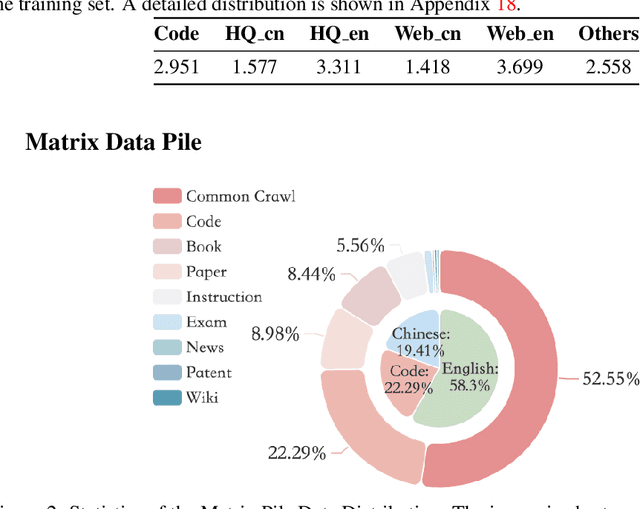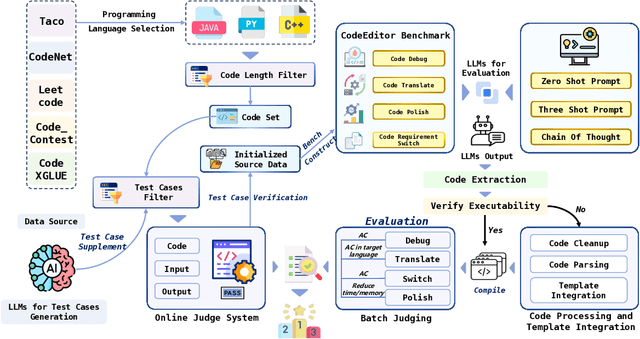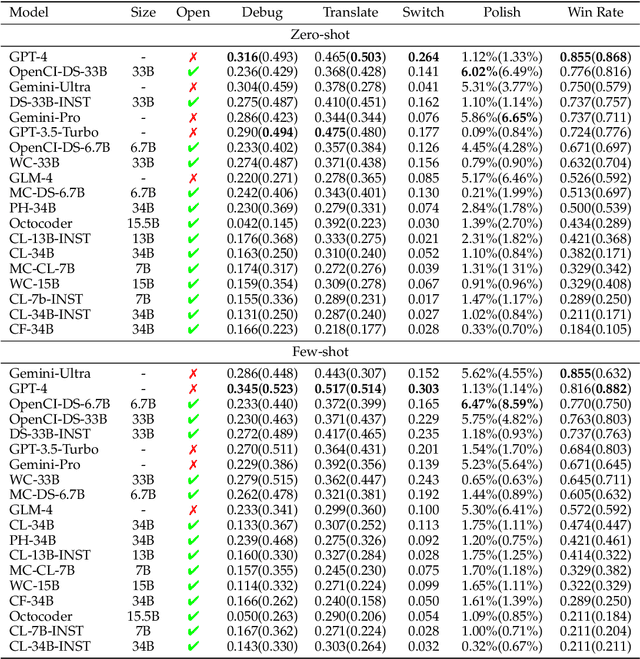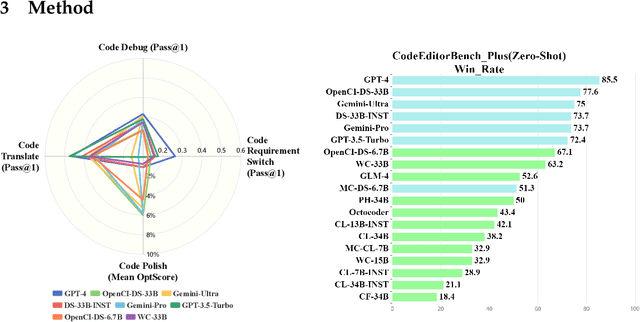Kaijing Ma
SuperGPQA: Scaling LLM Evaluation across 285 Graduate Disciplines
Feb 20, 2025Abstract:Large language models (LLMs) have demonstrated remarkable proficiency in mainstream academic disciplines such as mathematics, physics, and computer science. However, human knowledge encompasses over 200 specialized disciplines, far exceeding the scope of existing benchmarks. The capabilities of LLMs in many of these specialized fields-particularly in light industry, agriculture, and service-oriented disciplines-remain inadequately evaluated. To address this gap, we present SuperGPQA, a comprehensive benchmark that evaluates graduate-level knowledge and reasoning capabilities across 285 disciplines. Our benchmark employs a novel Human-LLM collaborative filtering mechanism to eliminate trivial or ambiguous questions through iterative refinement based on both LLM responses and expert feedback. Our experimental results reveal significant room for improvement in the performance of current state-of-the-art LLMs across diverse knowledge domains (e.g., the reasoning-focused model DeepSeek-R1 achieved the highest accuracy of 61.82% on SuperGPQA), highlighting the considerable gap between current model capabilities and artificial general intelligence. Additionally, we present comprehensive insights from our management of a large-scale annotation process, involving over 80 expert annotators and an interactive Human-LLM collaborative system, offering valuable methodological guidance for future research initiatives of comparable scope.
KARPA: A Training-free Method of Adapting Knowledge Graph as References for Large Language Model's Reasoning Path Aggregation
Dec 30, 2024Abstract:Large language models (LLMs) demonstrate exceptional performance across a variety of tasks, yet they are often affected by hallucinations and the timeliness of knowledge. Leveraging knowledge graphs (KGs) as external knowledge sources has emerged as a viable solution, but existing methods for LLM-based knowledge graph question answering (KGQA) are often limited by step-by-step decision-making on KGs, restricting the global planning and reasoning capabilities of LLMs, or they require fine-tuning or pre-training on specific KGs. To address these challenges, we propose Knowledge graph Assisted Reasoning Path Aggregation (KARPA), a novel framework that harnesses the global planning abilities of LLMs for efficient and accurate KG reasoning. KARPA operates in three steps: pre-planning relation paths using the LLM's global planning capabilities, matching semantically relevant paths via an embedding model, and reasoning over these paths to generate answers. Unlike existing KGQA methods, KARPA avoids stepwise traversal, requires no additional training, and is adaptable to various LLM architectures. Extensive experimental results show that KARPA achieves state-of-the-art performance in KGQA tasks, delivering both high efficiency and accuracy. Our code will be available on Github.
Trusted Unified Feature-Neighborhood Dynamics for Multi-View Classification
Sep 01, 2024Abstract:Multi-view classification (MVC) faces inherent challenges due to domain gaps and inconsistencies across different views, often resulting in uncertainties during the fusion process. While Evidential Deep Learning (EDL) has been effective in addressing view uncertainty, existing methods predominantly rely on the Dempster-Shafer combination rule, which is sensitive to conflicting evidence and often neglects the critical role of neighborhood structures within multi-view data. To address these limitations, we propose a Trusted Unified Feature-NEighborhood Dynamics (TUNED) model for robust MVC. This method effectively integrates local and global feature-neighborhood (F-N) structures for robust decision-making. Specifically, we begin by extracting local F-N structures within each view. To further mitigate potential uncertainties and conflicts in multi-view fusion, we employ a selective Markov random field that adaptively manages cross-view neighborhood dependencies. Additionally, we employ a shared parameterized evidence extractor that learns global consensus conditioned on local F-N structures, thereby enhancing the global integration of multi-view features. Experiments on benchmark datasets show that our method improves accuracy and robustness over existing approaches, particularly in scenarios with high uncertainty and conflicting views. The code will be made available at https://github.com/JethroJames/TUNED.
Beyond Uncertainty: Evidential Deep Learning for Robust Video Temporal Grounding
Aug 29, 2024Abstract:Existing Video Temporal Grounding (VTG) models excel in accuracy but often overlook open-world challenges posed by open-vocabulary queries and untrimmed videos. This leads to unreliable predictions for noisy, corrupted, and out-of-distribution data. Adapting VTG models to dynamically estimate uncertainties based on user input can address this issue. To this end, we introduce SRAM, a robust network module that benefits from a two-stage cross-modal alignment task. More importantly, it integrates Deep Evidential Regression (DER) to explicitly and thoroughly quantify uncertainty during training, thus allowing the model to say "I do not know" in scenarios beyond its handling capacity. However, the direct application of traditional DER theory and its regularizer reveals structural flaws, leading to unintended constraints in VTG tasks. In response, we develop a simple yet effective Geom-regularizer that enhances the uncertainty learning framework from the ground up. To the best of our knowledge, this marks the first successful attempt of DER in VTG. Our extensive quantitative and qualitative results affirm the effectiveness, robustness, and interpretability of our modules and the uncertainty learning paradigm in VTG tasks. The code will be made available.
Disentangle and denoise: Tackling context misalignment for video moment retrieval
Aug 14, 2024Abstract:Video Moment Retrieval, which aims to locate in-context video moments according to a natural language query, is an essential task for cross-modal grounding. Existing methods focus on enhancing the cross-modal interactions between all moments and the textual description for video understanding. However, constantly interacting with all locations is unreasonable because of uneven semantic distribution across the timeline and noisy visual backgrounds. This paper proposes a cross-modal Context Denoising Network (CDNet) for accurate moment retrieval by disentangling complex correlations and denoising irrelevant dynamics.Specifically, we propose a query-guided semantic disentanglement (QSD) to decouple video moments by estimating alignment levels according to the global and fine-grained correlation. A Context-aware Dynamic Denoisement (CDD) is proposed to enhance understanding of aligned spatial-temporal details by learning a group of query-relevant offsets. Extensive experiments on public benchmarks demonstrate that the proposed CDNet achieves state-of-the-art performances.
MAP-Neo: Highly Capable and Transparent Bilingual Large Language Model Series
May 29, 2024



Abstract:Large Language Models (LLMs) have made great strides in recent years to achieve unprecedented performance across different tasks. However, due to commercial interest, the most competitive models like GPT, Gemini, and Claude have been gated behind proprietary interfaces without disclosing the training details. Recently, many institutions have open-sourced several strong LLMs like LLaMA-3, comparable to existing closed-source LLMs. However, only the model's weights are provided with most details (e.g., intermediate checkpoints, pre-training corpus, and training code, etc.) being undisclosed. To improve the transparency of LLMs, the research community has formed to open-source truly open LLMs (e.g., Pythia, Amber, OLMo), where more details (e.g., pre-training corpus and training code) are being provided. These models have greatly advanced the scientific study of these large models including their strengths, weaknesses, biases and risks. However, we observe that the existing truly open LLMs on reasoning, knowledge, and coding tasks are still inferior to existing state-of-the-art LLMs with similar model sizes. To this end, we open-source MAP-Neo, a highly capable and transparent bilingual language model with 7B parameters trained from scratch on 4.5T high-quality tokens. Our MAP-Neo is the first fully open-sourced bilingual LLM with comparable performance compared to existing state-of-the-art LLMs. Moreover, we open-source all details to reproduce our MAP-Neo, where the cleaned pre-training corpus, data cleaning pipeline, checkpoints, and well-optimized training/evaluation framework are provided. Finally, we hope our MAP-Neo will enhance and strengthen the open research community and inspire more innovations and creativities to facilitate the further improvements of LLMs.
CodeEditorBench: Evaluating Code Editing Capability of Large Language Models
Apr 06, 2024



Abstract:Large Language Models (LLMs) for code are rapidly evolving, with code editing emerging as a critical capability. We introduce CodeEditorBench, an evaluation framework designed to rigorously assess the performance of LLMs in code editing tasks, including debugging, translating, polishing, and requirement switching. Unlike existing benchmarks focusing solely on code generation, CodeEditorBench emphasizes real-world scenarios and practical aspects of software development. We curate diverse coding challenges and scenarios from five sources, covering various programming languages, complexity levels, and editing tasks. Evaluation of 19 LLMs reveals that closed-source models (particularly Gemini-Ultra and GPT-4), outperform open-source models in CodeEditorBench, highlighting differences in model performance based on problem types and prompt sensitivities. CodeEditorBench aims to catalyze advancements in LLMs by providing a robust platform for assessing code editing capabilities. We will release all prompts and datasets to enable the community to expand the dataset and benchmark emerging LLMs. By introducing CodeEditorBench, we contribute to the advancement of LLMs in code editing and provide a valuable resource for researchers and practitioners.
SciMMIR: Benchmarking Scientific Multi-modal Information Retrieval
Jan 24, 2024Abstract:Multi-modal information retrieval (MMIR) is a rapidly evolving field, where significant progress, particularly in image-text pairing, has been made through advanced representation learning and cross-modality alignment research. However, current benchmarks for evaluating MMIR performance in image-text pairing within the scientific domain show a notable gap, where chart and table images described in scholarly language usually do not play a significant role. To bridge this gap, we develop a specialised scientific MMIR (SciMMIR) benchmark by leveraging open-access paper collections to extract data relevant to the scientific domain. This benchmark comprises 530K meticulously curated image-text pairs, extracted from figures and tables with detailed captions in scientific documents. We further annotate the image-text pairs with two-level subset-subcategory hierarchy annotations to facilitate a more comprehensive evaluation of the baselines. We conducted zero-shot and fine-tuning evaluations on prominent multi-modal image-captioning and visual language models, such as CLIP and BLIP. Our analysis offers critical insights for MMIR in the scientific domain, including the impact of pre-training and fine-tuning settings and the influence of the visual and textual encoders. All our data and checkpoints are publicly available at https://github.com/Wusiwei0410/SciMMIR.
 Add to Chrome
Add to Chrome Add to Firefox
Add to Firefox Add to Edge
Add to Edge